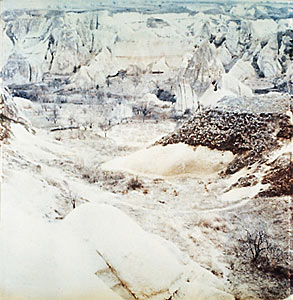
Born in 1954 in Bonn (DE)
Lives and works in Essen and Wismar (DE)

1989
Cibachrome
Agrandissement d'un polaroïd
100 x 103 cm
Year of Purchase: 1990
Maron, a student of Otto Steinert in Essen, belongs to the Subjektive Fotografie movement which developed in Germany in the 1950s. His is a plastic style of photography in which reality is manipulated, internalized and poeticized. He is searching for a quintessence of the contemplative attitude and dissolves the gaze, evaporating it in the radiance of colour. Space flattened by the burning of light is turned into a universe and an atmosphere. The photograph establishes at once a presence and a distance with the measurable physical world. It is from Oriental philosophy that Maron duly borrows the transcending vision of an inclusion of the microcosm within the macrocosm, and fills the world with symbolic meanings.
Burnt out, irreal landscapes, extracts from an inner world, the photographs of Knut Wolfgang Maron display arid expanses, gnawed at by light, in which at times there appear silhouettes of people and animals, prey to mental transhumant shifts, as if lost in the immeasurable space of an archaic nature. Be it veil or trace of dreamlike experiences stemming from the depths of memory, in this place where the secrets of the soul are turned into strange and incongruous forms, these images involve viewers in a melancholic stroll towards their own imagination.
These photographs ‘are places of being, fields of energy in which modern man, invaded by conflict, his nerves in tatters, his thought in shreds, may roam in silence, go astray in the immensity and find that he is someone quite different.’ [Kenneth White, unpublished]. In them, Maron builds a vision of the world in which the earth bears the trace of man and vice versa. He photographs nature like a living skin (Esterel II), reveals the anthropomorphic quality of natural elements like sea salt transported by the sky, crystalized on the slopes of the Goudes. Similarly, man leaves his mark in the world by way of transformation, it is the imagination, he creates the fire which haunts the photograph, and metamorphoses the measure of the landscape.
Maïté Vissault